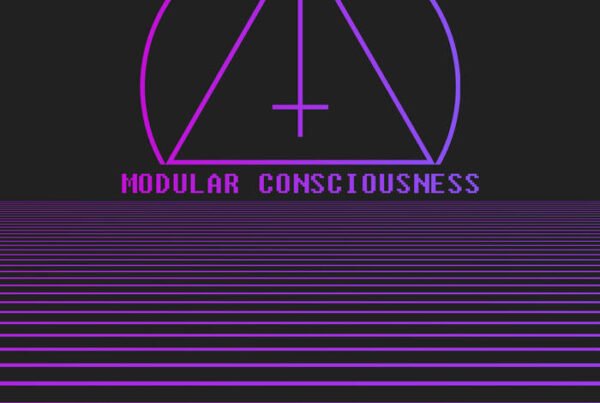Maud the Moth isn’t an artist who simply follows a path. Instead, she carves out her own, with every album feeling like a step deeper into a world which is hers alone. With her latest release, she once again pushes the boundaries of what we’ve come to expect, showcasing more of the profoundly evocative atmospheres that have define her sound. It’s a journey that feels both familiar and new, pulling you into spaces where the unexpected always waits just around the corner. I spoke about Orphnē, when it was released, with much fervor, although I can’t say that The Distaff elicits quite the same response from me, at least not at an emotional level. Though, it is undeniable that The Distaff is an outstanding record.
I’m not usually the one to tack press quotes onto my articles, in any shape or form, however, I think that in this instance there’s some much needed background on the innards of The Distaff, put in a way which I wouldn’t have arrived to, at least not in a timely manner.
‘The Distaff refers to the wooden rod historically used for spinning fibers into thread. In the collective imagination, this object is a symbol of the ‘virtuous woman’, an ideal imposed by authoritarian and patriarchal societies. It serves as the axis around which much of the trauma and guilt associated with femininity revolve.
‘The album’s title is partly inspired by one of the earliest examples of female literature: the poem of the same name by Greek poet Erinna. In the poem, the author laments the loss of individuality and agency of her friend Baucis after marriage—a price paid for security and societal acceptance.
‘The album exists in a realm that is both ethereal and violent, filled with aesthetic overlaps and dreamlike anachronisms. A reimagined folklore sits at the table alongside Maud the Moth’s usual diverse sonic palette. With a sound impossible to categorize, glimpses of different musical genres merely hint at Amaya’s artistic interests.’
I am especially fond of this particular characterization of the music, as being in a realm that is both ethereal and violent. Mostly due to the fact that this ‘violence’ is not only relatable at a very primordial level, but it’s also a striking and fundamental part of the delivery of everything. This visceral edge cuts to the core of your soul from the very first moments and it only eases up as soon as the music ceases to play. It’s reflected in every aspect too, which makes it so much more impactful. It can be seen how structurally there’s a lot more borrowed from rock, although tonally as well and even though it’s neatly spread throughout, it’s made obvious right away on “A Temple by the River”. The vocal delivery soars, becoming at times shrill in a painful way, like a blinding light, something which, while very fitting aesthetically, can become tiresome, particularly during the ending of “Fiat Lux”.
The ethereal side of things is as present as could be expected based on previous works. It’s also a central part of the oddball charm and the surprising level of immersiveness of the tunes. There’s something hypnotically alluring, to me at least, about something that feels so unremittingly strange, otherworldly, inaccessible, and arcane. It’s something that transcends curiosity and isn’t a fleeting fascination with something novel. I’m not sure from what unbelievable distance are these musical ideas brought from, from what corner of the ether, but it has to be something unfathomable. It’s immediately obvious to anyone listening. That’s why it immediately feels so off, in such a neat way. You can feel it’s something from far, so far that it’s like a parallel universe away and this is the only medium through which it can be accessed. Somewhere there, at the fringes of this other existence, there is another who, somehow, shares these feelings and as such a portal is created in the form of this album.
Sure, that’s one side of it all – the otherworldly impulse, carried by a telluric presence, highlighting worldly troubles and beauties, which in itself is truly a spectacle to behold. The other side being the outstanding elegance of it all. It’s difficult to appropriately assess in words what it really is, but it’s something that isn’t determined by neither part which assembles this album. Imagine if you’d have the dexterity to write a poem on the finest parchment with an axe, while dancing in front of thousands of people. The Distaff is sort of the reverse of that, if that makes any sense.
The impact is probably what sold me the most on The Distaff. I have a massive weakness for works which have a tendency to be so unapologetically rapturous, as if all the performers are playing magnesium flames as musical instruments. Yet, I could not in any shape or form say that this thespian inclination is forced, or overdone. I do have to appreciate something that’s dialed in to the maximum setting, without appearing gauche. Though, I have to repeat myself, there are a couple of moments which can feel fatiguing to some – granted that might also be exposure bias – listening to a record well over a couple of dozen times can do weird things to your brain.
I can’t shake off this feeling of futility, when attempting to encompass such records, so I advise you to proceed like me: say something, if you feel like you have something to say and then just urge whomever to listen to The Distaff, while also checking it out for yourself. It really is more of an experience than an album.






